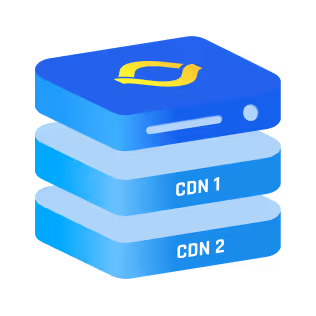Video content is everywhere today, and streaming has become a way of life. Whether it's YouTube, Netflix, or a live sports event, you've probably noticed that some videos take longer to load than others.
In 2023, 82.5% of all global internet traffic was attributed to video streaming and downloads, and it’s only rising ever since.
Have you ever wondered how platforms like these can stream such high-quality content so smoothly? That’s where something called video caching comes into play. Let's break it down.
What is Video Cache?
Video cache refers to the temporary storage of video files in a local server or your device, allowing for faster loading and smoother playback when streaming content. Think of it as a middleman: instead of fetching the video from the main source each time you hit play, the system grabs it from a nearby location or your device’s memory. This reduces buffering time and ensures that the video plays without interruptions.
For instance, when you first watch a video, a copy of it is stored in a temporary folder called a video cache. If you decide to watch the video again later, instead of downloading it again, your device will pull it from the cache, making the process quicker and smoother.
Importance of Video Caching in Modern Streaming
As video content becomes more prevalent, video caching has grown in importance. Streaming services need to handle millions of users watching the same content at the same time. Without video caching, every single user would need to access the original video source every time they hit play, leading to slow load times, interruptions, and overall poor quality.
By storing video files closer to the user or device in a video cache server, these services can drastically improve the viewing experience. It’s about reducing the amount of data transferred, cutting costs for streaming platforms, and ensuring that even users with slower internet connections can still enjoy high-quality content.
How Does Video Caching Work?
At its core, video caching is about optimizing access to video content. Here’s a simplified explanation:
- First-time access: When you stream a video for the first time, it’s delivered from the original server, or a video cache server, close to your location. As you watch the video, parts of it are saved on your device or a local server as cached data.
- Subsequent access: When you revisit that video, instead of fetching it again from the original source, the cached version is used, allowing the video to load instantly or with significantly reduced buffering.
This happens across networks, not just your personal devices. For example, a video caching solution might store frequently accessed videos in locations across the globe.
So, if you and millions of other people are watching the same viral video, you’ll all be pulling from a cached version instead of the central server.
Why You Need To Clear Video Cache:
While video caching is useful, cached files can take up space on your device over time. If you're noticing slow performance or experiencing playback issues, you might need to clear the video cache. Doing so deletes the temporary files stored in your system and frees up space.
On streaming platforms, sometimes a video won’t load correctly due to a corrupted cache file, and clearing the cache resolves that problem.
Many browsers and devices allow you to easily clear cached data, ensuring smoother video performance moving forward.
Types of Video Caching
There are different types of video caching that optimize the process depending on the use case. Here are a few common ones:
- Device caching: This occurs locally on your computer, phone, or tablet. When you stream content, a copy is temporarily stored on your device so that the next time you access it, it’s faster.
- Edge caching: This involves storing the video in servers that are closer to the end user. Instead of retrieving the content from the central server, it’s stored in locations near the user to reduce the distance data has to travel.
- CDN caching: Content Delivery Networks (CDNs) use servers all over the world to store and distribute content. Video caching in CDNs is essential to ensure that users, no matter where they are, get fast and reliable access to videos.
- Browser caching: This type of caching happens within your browser. When you visit a website with video content, parts of the site—including videos—are cached. So, when you revisit, it loads faster.
Key Benefits of Video Caching
The benefits of video caching go beyond just a better user experience. Here’s why it matters:
- Reduced buffering: Video caching reduces the need to continuously fetch data from far-off servers, which means you can watch videos without annoying pauses for buffering.
- Faster load times: Cached videos load much faster since they’re stored locally or on nearby servers.
- Lower bandwidth usage: With a cached video, you're using less data. This is especially beneficial for users with limited data plans or slower internet connections.
- Improved server performance: By reducing the load on the main server, video caching helps improve the overall performance of streaming platforms.
- Cost-effective for service providers: Video caching saves bandwidth and resources for streaming platforms, making it a more economical solution.
{{cool-component}}
Video Caching Mechanisms
There are various ways video caching mechanisms are implemented, depending on the type of content and user needs. Here are a few common methods:
- Partial caching: Only portions of the video are cached, especially the beginning parts. This ensures that the video starts playing quickly, even if the rest is not fully loaded yet.
- Adaptive bitrate streaming: This allows the cache to store multiple versions of the same video at different quality levels. Depending on the user’s internet connection, the system can deliver the best quality available from the cache.
- Progressive downloading: Here, videos are downloaded in small chunks rather than all at once. As the viewer watches the video, the cache downloads more chunks in real-time, allowing for smoother streaming.
Video Cache Downloaders
Ever wished you could save a video to watch later without buffering? A video cache downloader can help with that. These tools allow you to download videos directly from the cache so that you can play them offline or save them for future viewing.
It’s a practical solution if you're in a place with limited or no internet connectivity, but you still want access to your favorite content.
Video Caching in Content Delivery Networks (CDNs)
Content Delivery Networks (CDNs) play a pivotal role in video caching. CDNs use a vast network of servers spread across the globe to cache and deliver content. This allows for quicker access to video content for users, regardless of their location.
When you hit play on a video, you’re not necessarily retrieving the content from the streaming platform’s main servers. Instead, you’re likely accessing a cached version stored in a video cache server in a CDN close to you.
This not only speeds up delivery but also helps prevent network congestion, especially when millions of users are watching the same content. CDNs are crucial to maintaining the speed and reliability of today’s high-demand video streaming services.
Conclusion
To sum it all up, be it helping millions of users watch the same video without buffering or saving data on your device, caching ensures that videos are delivered quickly and efficiently. It’s an extremely core tool in modern video streaming architectures, and it impacts your daily online experience—especially when it comes to streaming your favorite videos.
FAQs
What is a video cache server and how does it work?
A video cache server is a localized storage appliance or virtual node that keeps copies of popular video segments near the audience. When a player requests a file, the server serves it instantly; only cache misses travel upstream to the origin, slashing latency and origin egress.
How does video caching improve streaming performance for users?
By leveraging edge caching for video, segments are fetched from a nearby node rather than a distant origin. The shorter round-trip yields faster start-up, fewer buffer stalls, and higher video bitrates. This video streaming optimization translates into better Quality of Experience (QoE) and longer viewer watch times.
What’s the difference between edge caching and CDN caching for video?
Edge caching places video files on servers inside the ISP or metro network, often one hop from the viewer. Traditional CDN video delivery may cache at regional PoPs that sit farther away, adding extra hops. Edge reduces last-mile congestion; CDN PoP caches provide global reach and redundancy.
Can video cache help reduce bandwidth costs for streaming services?
Yes. Serving popular titles from a video cache server slashes origin egress traffic, which is typically billed per gigabyte. Large platforms report 60–90 % cache-hit ratios, turning into meaningful bandwidth savings. Lower upstream costs mean more sustainable margins for subscription and ad-supported streaming services.
Is it possible to manually clear or manage video cache on end-user devices?
Most mobile and OTT apps auto-manage cache space, but users can usually clear it under app settings or browser storage. Manually flushing cached segments frees memory and can resolve playback errors, though it resets adaptive bitrate history, temporarily reducing video streaming optimization until the cache repopulates.



.png)
.png)
.png)






